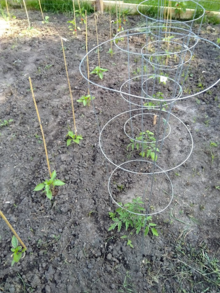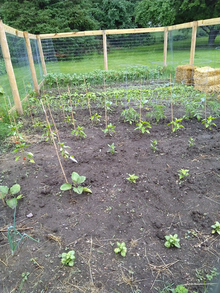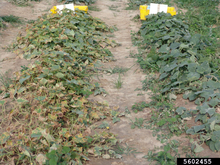June is a time for vegetable garden optimism. Carefully raised seedlings are being pulled out of basements, and Minnesotans are rolling cart loads of plants from garden centers. This can feel like a season for doing—raking, weeding, planting, watering and mulching.
Future disease issues aren’t top of mind for most gardeners, but later in the season they undoubtedly will show up. The decisions you make now can have a huge impact on the health of your garden come August.
Be realistic about your space
Many gardeners are working with limited space, and the biggest thing you can do to help your garden is to be realistic about what can fit in that space. Yes, I do want every purple cherry tomato, gargantuan beefsteak, streaked heirloom, and hybrid sauce tomato. Before I throw them all in my cart, I need to be honest with myself about what can fit in my small backyard garden.
A key element in almost every plant disease is water. The more clustered and dense our vegetable garden canopies, the longer the water from our hose or the morning’s dew can sit on the plants. The longer this period of time, the greater the chance of plant disease developing.
For our beloved tomatoes, the humidity and morning dew mean that tomato diseases are a fact of gardening life in our state, but we can stall them by helping our plants dry out. This starts now, by giving our plants enough space.
The cute little transplants we are putting out now don’t stay small for long. Vine crops will grow and cover many feet, and the spindly cherry tomato plant will keep growing and growing until frost or disease takes it out.
Each vegetable and variety has slightly different space requirements, so before you head out to get plants, measure out your garden and picture in your head what can realistically fit. For example, an indeterminate cherry tomato that grows all season long will need 2-3 feet of space in every direction, while cabbage needs 15 to 18 inches.
Check out the tags of what you’re planting or the seed packet for spacing advice. If you've heard the fashion advice of taking off one accessory before you leave the house, when I am over excited at the garden center, I put one tomato plant back before I hit checkout.
Think back to your past disease issues
While it can be painful to remember the time your tomato plants died before you ever got to harvest anything or the mystery spots that slowly killed your pumpkin plant, remembering these issues and having them identified is a big step in avoiding them in the future.
Many vegetables have varieties that are resistant to different diseases, and by planting these varieties in your space you can avoid running into them again this year. Check the tags or do a quick internet search to see if what you’re thinking about planting have any resistances that can help you have a successful garden this year.
Once you’re in the garden, rotate!
In my garden, it is tempting to put the stuff in the same place this year. I loved where my herbs were, they were so close to by the back door for quick harvest, and putting the squash tucked away in the back allowed them to grow unencumbered. But planting the same plants in the same space year after year promotes diseases.
Vegetable diseases tend to be a) limited to one plant family and b) stick around in the soil for a few years. If you have multiple raised beds, plant vegetables in different beds than they were in last year. If you are more space-limited and have the option to put disease-prone vegetables that you really love into pots, consider doing this to avoid disease.
For more tips on rotation, see Rotate crops in your small garden.
Keep an eye on plants as the season progresses
The weekend you weed, fertilize, plant, and mulch is tiring, and it is tempting to kick back for the rest of the month. Check in on plants regularly and look for leaf feeding or spots, and if you see anything, take a closer look to diagnose what you are seeing. This doesn’t have to be super formal – it could be a quick once-over as you walk to the garage or pick up after your dog. A little attention can allow you to catch problems while you can still take action.




